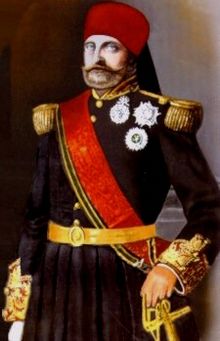Muhammad II ibn al-Husayn
| Muhammad II ibn al-Husayn | |
|---|---|
 | |
| Bey of Tunis | |
| Reign | 30 May 1855 – 22 September 1859 |
| Predecessor | Ahmad I ibn Mustafa |
| Successor | Muhammad III as-Sadiq |
| Born | 18 September 1811 Le Bardo, Beylik of Tunis |
| Died | 22 September 1859 (aged 48) Dar al-Taj Palace, La Marsa, Beylik of Tunis |
| Burial | Tourbet el Bey, Tunis, Tunisia |
| Issue | Muhammad V an-Nasir Sidi Hassine Bey Sidi Saïd Bey Lalla Fatima Lalla Khadija Lalla Salouha Lalla Zoubeïda |
| Dynasty | Husainides |
| Father | Hussein II Bey |
| Religion | Islam |
Mohammed Bey (Arabic: أبو عبد اله محمد باشا باي) or M'hamed Bey (18 September 1811 – 22 September 1859)[1][2][3] was the eleventh Husainid Bey of Tunis, ruling from 1855 until his death.[4] He was the son of Al-Husayn II ibn Mahmud and his second wife Lalla Fatima al-Munastiri.[citation needed]
As Bey al-Mahalla (Heir Apparent) he had been awarded the rank of divisional general in the Ottoman army in August 1840, and was raised to the rank of marshal on 7 August 1855, shortly after he succeeded his cousin Ahmad Bey on 30 May 1855. He retained his predecessor's key minister Mustapha Khaznadar as Grand vizier[5] and surrounded himself with competent ministers such as Kheireddine Pacha and Generals Hussain and Rustum as well as devoted counsellors including Mohamed Bayram IV, Mahmoud Kabadou and Ismaïl Caïd Essebsi.

After his accession he proceeded with reforms, including, on 10 September 1857, the Fundamental Pact which recognised religious freedom and equality before the law for all inhabitants of the country, regardless of their religion.[6] In a decree of 30 August 1858, he established the first modern municipal government for the city of Tunis.[7]
He considerably extended and embellished the Dar al-Taj Palace in La Marsa, stripping the old Mohamedia Palace favoured by his predecessor of building materials to do so.[8]
He died after only four years on the throne and was buried in the Tourbet el Bey in the Medina of Tunis.[2]
References
[edit]- ^ Ibn Abi Dhiaf, Présent des hommes de notre temps. Chroniques des rois de Tunis et du pacte fondamental, vol. IV, éd. Maison tunisienne de l'édition, Tunis, 1990, p. 207
- ^ a b Ibn Abi Dhiaf, op. cit., p. 293
- ^ G. S. van Krieken, Khayr al-Dîn et la Tunisie, 1850-1881, éd. Brill, Leyde, 1976, p. 36
- ^ Armand de Flaux, La régence de Tunis au dix-neuvième siècle, éd. Challamel Aîné, Paris, 1865, p. 238
- ^ Ibn Abi Dhiaf, op. cit., p. 210
- ^ Nazli Hafsia, Les premiers modernistes tunisiens. Abdeljelil Zaouche. 1873-1947, éd. MIM, Tunis, 2007, pp. 60–61
- ^ Paul Sebag, Tunis. Histoire d'une ville, éd. L'Harmattan, Paris, 1998, p. 289
- ^ Jacques Revault, Palais et résidences d'été de la région de Tunis (XVIe-XIXe siècles), éd. Centre national de la recherche scientifique, Paris, 1974, p. 74


 French
French Deutsch
Deutsch